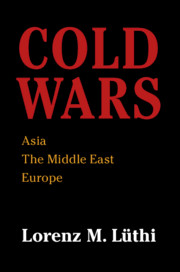Book contents
- Cold Wars
- Cold Wars
- Copyright page
- Dedication
- Contents
- Maps
- Acknowledgments
- Note on Names, Transliterations, and References
- Abbreviations
- Introduction
- 1 From High Imperialism to Cold War Division
- Part I Elusive Unities
- Part II Asia
- Part III The Middle East
- Part IV Alternative World Visions
- Part V Europe between the Superpowers
- Introduction to Chapters 14 to 16
- 14 Nuclear Weapons
- 15 Western European Integration
- 16 The Council for Mutual Economic Assistance
- Part VI European Détente
- Part VII The End of the Regional Cold Wars
- Notes
- Index
16 - The Council for Mutual Economic Assistance
from Part V - Europe between the Superpowers
Published online by Cambridge University Press: 19 March 2020
- Cold Wars
- Cold Wars
- Copyright page
- Dedication
- Contents
- Maps
- Acknowledgments
- Note on Names, Transliterations, and References
- Abbreviations
- Introduction
- 1 From High Imperialism to Cold War Division
- Part I Elusive Unities
- Part II Asia
- Part III The Middle East
- Part IV Alternative World Visions
- Part V Europe between the Superpowers
- Introduction to Chapters 14 to 16
- 14 Nuclear Weapons
- 15 Western European Integration
- 16 The Council for Mutual Economic Assistance
- Part VI European Détente
- Part VII The End of the Regional Cold Wars
- Notes
- Index
Summary
The socialist economic system in Eastern Europe—the Council for Mutual Economic Assistance—was established in 1949. Most of the countries there did not join the CMEA because they genuinely believed in its purpose of rivaling the capitalist half of Europe. Stalin forced in order to protect Soviet influence there. Yet even he seemed not to be convinced about the viability of the CMEA. Several socialist states opted out of the idea of an integrated socialist economic system within two decades—Yugoslavia, China, Albania, and Romania. Because the USSR was the dominant member, it initiated several rounds of reforms from the mid 1950s to the 1970s to provide the CMEA with greater purpose and direction in the competition with the capitalist West. But the structural and ideological foundations, which Stalin had put in place before 1953, remained remarkably resistant to change. Thus, within two decades of the end of Worl War II, Soviet-controlled Eastern Europe turned from a source of reparations into an economic liability for the USSR. By the late 1970s, virtually all CMEA members understood that the organization had failed to deliver it had set out to do.
- Type
- Chapter
- Information
- Cold WarsAsia, the Middle East, Europe, pp. 381 - 406Publisher: Cambridge University PressPrint publication year: 2020

